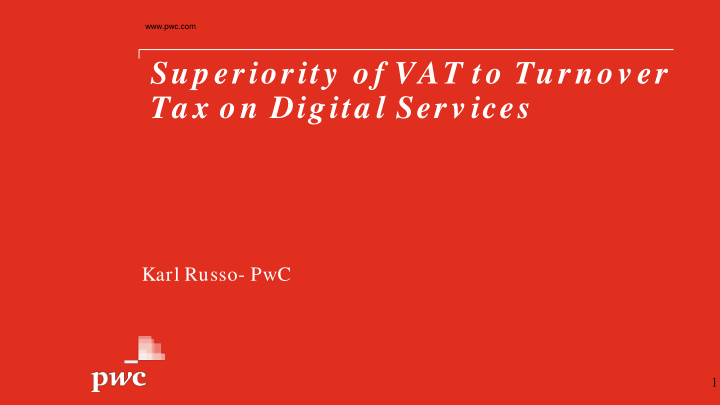



www.pwc.com Sup eriority of VAT to Turnov er Ta x on Digita l Serv ices Karl Russo- PwC 1
International Obligations • “ Questions about the com patibility … w ith the double-taxation treaties, State aid rules, fundam ental freedom s, and international com m itm ents under the free trade agreem ents and WTO rules w ould need to be exam ined.” – EC COM(2017) 547 final • Income tax treaties – double taxation/ crediting issues • State aid rules – Hungary’s advertisement tax • WTO – EC “a specific threshold above EUR 50 million could risk a de-facto discrimination.” What about unilateral thresholds??? • Grinberg - “the EU’s regime for taxing the sale of all electronic services… .should not violate national treatment obligations under Article III of the GATT and Article XVII of the GATS” 2
International Obligations • EU forbids turnover tax other than VAT • Essential VAT characteristics: 1) applies generally to transactions relating to goods or services • 2) proportional to the price charged • 3) charged at each stage of the production and distribution process • 4) tax applies only to the value added at that stage and final burden rests on the consumer. • • Impact assessment tries to flunk these criteria, but… • Turina (2018) questions whether “stressing the dissimilarity of equalization levies from VAT should be encouraged or, instead, the potential for convergence should be seized as an opportunity … to provide a response to the current tax challenges of the digital economy… .[I]t forces one to contemplate whether, at least from an EU perspective, the most suitable avenue for intervention might lie not so much in the realm of direct taxation (or of a direct tax ‘disguised’ as an indirect one) but, rather, in a comprehensive reform of indirect tax rules dealing with digital supplies.” 3
Enacted and Proposed DSTs • Enacted DST – France, Hungary, India • Proposed DST – Austria, Chile, EU, France, Italy, Spain, Turkey, UK • VAT treatment – Australia, EU, Japan, New Zealand, South Korea • New EU VAT rules in force by 2021 – Mucsovici “Brick by brick and piece by piece, a new VAT system is being built that is fit for ▪ purpose and within which internet companies operating across borders can thrive. At the same time, we are making sure that non-EU businesses do not get preferential treatment when selling to EU consumers - both directly and through online marketplaces.” • Israel – considering DST in lieu of expanding VAT to cover B2C digital goods and services 4
VAT vs. Turnover Tax – Incidence • Competitive markets have incidence on the consumer • Are digital markets competitive? Network effects and low marginal cost tend toward monopoly/oligopoly ▪ Competition for digital advertising (search engine vs. social media) ▪ Competition from television, print, and radio advertising ▪ • May not matter Beverages: at least some shifting and maybe overshifting ▪ Tobacco: full or overshifting ▪ Gasoline: full shifting, nearly 95 percent in rural quasi-monopolistic markets ▪ 5
VAT vs. Turnover Tax – Efficiency • Production Efficiency- taxes on inputs distort choices Which business inputs to use in production • Whether to purchase or produce inputs internally • “remain[s] the best guiding principle for practical tax design. The requirement of • production efficiency…is a key reason for the use of the VAT” – Crawford, Keen, Smith (2010) Implies that turnover taxes are inefficient • • Cascading Distorts relative prices of business inputs • Increases effective tax rate on inputs, exacerbating distortions • Alters relative prices of final goods, distorting consumption decisions • Avoidance not automatic – EU and French proposals to prevent • 6
Special rate on digital services – economic rationale • Theoretical rationale to tax certain items more heavily • Leisure complements Social media complementary with leisure (Keen et al., 2019) but substitute for other • leisure (Twenge et al., 2018). Net effect unclear. Internet search improves productivity $49b to $73b, more than $41.9b it increases • consumer surplus (Bughin et al., 2011) Tax applies not to those activities directly, but to business input of advertising • • Goods and services less subject to or with higher cost of evasion Ease of avoidance and evasion cited by EC as motivation for DST • • Negative externalities Negative externalities with respect to privacy, adverse price discrimination, unwanted • solicitation Positive externalities with respect to niche markets, insurance and credit access, third- • party authentication, drug interactions, infectious disease monitoring 7 Net could imply tax or subsidy •
Special rate on digital services – implementation issues • EC: “higher VAT rates for certain digital services would run counter to the principle in the VAT Directive that all goods or services could only be taxed up to the standard rate.” • Administrative and compliance costs • Rate differentiation encourages rent seeking “more likely to be driven by lobbying and political realities than unbiased econometric analysis” (Benge, Pallot, and Slack, 2013) • Concerns about ring-fencing the digital economy, which are exacerbated if tax is restricted to a subset of digital services 8
Conclusion • Indirect taxes to satisfy international obligations • VAT is superior to turnover tax on efficiency grounds Turnover tax likely has similar incidence on consumers • More likely to distort production decisions and risk cascading and double taxation • • Unclear whether rationales for special higher rate indirect tax applies to digital services • Administrative concerns weigh against doing so anyway • VAT being applied effectively • Pursue/ accelerate these efforts rather than interim measures that tax turnover while the broader international community seeks a consensus-based long-term solution 9
Recommend
More recommend